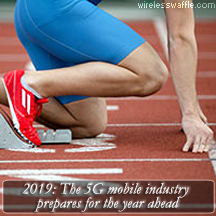 2018 was hopefully the year in which 5G hype peaked. Lots of mobile operators and equipment manufacturers were desperate to jump on the band-wagon and proclaim their plans to launch or operate 5G services or devices to be the first out of the running blocks. The simple fact, however, was that the 5G standard was delayed for 3 months until June 2019, and as of yet, there is no internationally agreed spectrum for 5G services.
2018 was hopefully the year in which 5G hype peaked. Lots of mobile operators and equipment manufacturers were desperate to jump on the band-wagon and proclaim their plans to launch or operate 5G services or devices to be the first out of the running blocks. The simple fact, however, was that the 5G standard was delayed for 3 months until June 2019, and as of yet, there is no internationally agreed spectrum for 5G services.2019 will hopefully be the year in which some of the hype begins to melt, and reality sets in. Prime amongst this will be the decisions taken at the ITU's World Radiocommunications Conference (WRC-19) which is due to take place in Sharm El-Sheikh in Egypt in November. One of the Agenda Items for the confernence, if not the most important agenda item of the conference, is number 1.13, whose snappy title is:
To consider identification of frequency bands for the future development of International Mobile Telecommunications (IMT), including possible additional allocations to the mobile service on a primary basis, in accordance with Resolution 238 (WRC-15).
 IMT is the ITU's terminology for commercial mobile communications and there are actually three flavours, IMT (2G and 3G), IMT-Advanced (4G) and IMT-2020 (5G). Before any radio spectrum can be formally used for IMT services of any kind, there are two prerequisites. Firstly the spectrum must have a 'mobile' allocation in the country in which it is to be used. Such an allocation will be found in the country's national frequency allocation plan. And in theory, if it is to be used for mobile services, it should also have been identified by the ITU as spectrum for IMT. All of the current mobile bands (e.g. 700, 800, 900, 1800, 2100, 2600 MHz) are in pieces of spectrum that have this identification.
IMT is the ITU's terminology for commercial mobile communications and there are actually three flavours, IMT (2G and 3G), IMT-Advanced (4G) and IMT-2020 (5G). Before any radio spectrum can be formally used for IMT services of any kind, there are two prerequisites. Firstly the spectrum must have a 'mobile' allocation in the country in which it is to be used. Such an allocation will be found in the country's national frequency allocation plan. And in theory, if it is to be used for mobile services, it should also have been identified by the ITU as spectrum for IMT. All of the current mobile bands (e.g. 700, 800, 900, 1800, 2100, 2600 MHz) are in pieces of spectrum that have this identification.The Agenda Item is investigating a wide range of frequency bands ranging from 24.25 to 86 GHz.
| Frequency Range | Amount of Spectrum |
|---|---|
| 24.25 - 27.5 GHz | 3.25 GHz |
| 31.8 - 33.4 GHz | 1.6 GHz |
| 37.0 - 43.5 GHz | 6.5 GHz |
| 45.5 - 50.2 GHz | 4.7 GHz |
| 50.4 - 52.6 GHz | 2.2 GHz |
| 66.0 - 76.0 GHz | 10.0 GHz |
| 81.0 - 86.0 GHz | 5.0 GHz |
| TOTAL | 33.25 GHz |
In total an increadible 33 GHz of new spectrum is being examined, which is in the order of 30 times more than has been identified as of today. Of this, it seems likely that something in the region of 20 GHz of spectrum will be identified for IMT. However, the waters are already being muddied by the organisations that manufacture mobile equipment and devices, and by one or two influential countries (e.g. the USA, Japan and China), and the nascent 5G standard includes the use of spectrum that is not part of the Agenda Item's studies.
In particular, the US, Japan and South Korea and others are proposing the use of a 28 GHz band (27.5 - 29.5 GHz) and South Korea, Japan and China are considering the use of a 4 GHz band (4.4 - 5.0 GHz), both bands, as it happens, being currently used for commercial satellite services. As these bands are not on the agenda for WRC-19, in theory they can not be identified for IMT meaning that they would be 'non-harmonised' bands. But in today's fast moving mobile industry, what really constitutes 'harmonised'? Does it mean that it has gone through the laborious 4 year ITU conference cycle, or does it mean that enough countries with sufficiently large populations to encourage economies of scale in manufacturing have got together and agreed a way forward.
 Many question the validity of the ITU process, saying that it is outdated, lethargic and even irrelevant. Some are even threatening to withdraw themselves, and their funding, from the organisation. That being said, it remains the process that most of the almost 200 members of the United Nations turn to, to help them align their use of the radio spectrum with the rest of the planet.
Many question the validity of the ITU process, saying that it is outdated, lethargic and even irrelevant. Some are even threatening to withdraw themselves, and their funding, from the organisation. That being said, it remains the process that most of the almost 200 members of the United Nations turn to, to help them align their use of the radio spectrum with the rest of the planet.The forthcoming WRC therefore, and the associated decisions on the frequency bands to use for 5G, stands to be fascinating, both from the perspective of the sheer amount of new mobile spectrum that could be available following the conference, and whether or not the rogue nations will be able to twist enough arms to get their positions ratified, or will just storm out of the room in a huff. Wireless Waffle, will, as always, keep you posted.
add comment
( 484 views )
| permalink
| 



 ( 2.6 / 1546 )
( 2.6 / 1546 )




 ( 2.6 / 1546 )
( 2.6 / 1546 )
Wireless Waffle intends to focus on developments in 5G mobile services amongst our usual flotsam and jetsam of scepticism and general incredulity over wireless matters. But what makes 5G different from 4G, or for that matter 4G from 3G? How are the ever faster connection speeds accomplished, and what are the implications for me and you? Over a series of posts, we intend to explain a little of what is behind these advances in mobile technology, which if nothing else, will serve to show just how sophisticated modern mobile networks are.
In old fashioned radio technologies, the transmitter uses a single antenna to emit a signal, and the receiver uses a single antenna to receive the signal (incidentally known as single input, single output or SISO). This works fine but neglects one of the most common propagation conditions that can upset reception of a radio signal: reflections. The reception of a signal reflected off an object in addition to the direct signal can lead to all manner of problems. One of the most common was, in the days of analogue television, what was known as 'ghosting'.
 Analogue television pictures are drawn line-by-line by a dot that whizzes across the screen from left to right. Any reflection will, by the simple laws of geometry, have travelled further than one directly from the transmitter and thus will take slightly longer to arrive. This produces a second image, that is 'delayed' compared to the direct signal, and this delayed picture would appear to the left of the main signal, as a ghost of the main picture.
Analogue television pictures are drawn line-by-line by a dot that whizzes across the screen from left to right. Any reflection will, by the simple laws of geometry, have travelled further than one directly from the transmitter and thus will take slightly longer to arrive. This produces a second image, that is 'delayed' compared to the direct signal, and this delayed picture would appear to the left of the main signal, as a ghost of the main picture.
In digital television, this problem has been dealt with by slowing down the transmission of the data, such that the typical length of a delay (measured in microseconds) is far less than the length of time used to send each bit, and thus you can effectively ignore the short period of time for which the delayed signal and the direct signal might be different from each other and switch off the receiver for a short while until the situation settles down. The time which the receiver waits for the situation to settle down is known as the guard interval and can be adjusted by the broadcaster to take account of different reflection environments (i.e. in a city where reflections tend to be strong, but over small distances, compared to in a rural area where the reflections might be from buildings or structures several kilometers away).
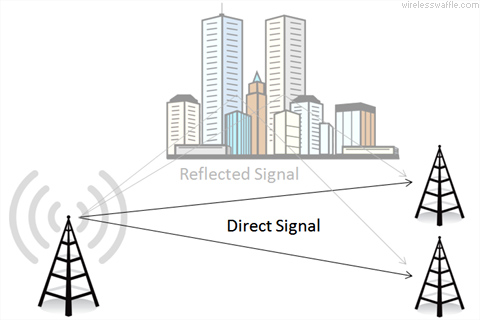
But what if you could be cleverer than just ignoring the reflection, and find a way of using it to benefit reception instead of being a detriment to it? Take the example illustrated above. A single transmitter is being received by two adjacent antennas, but as well as receiving a signal that has travelled directly from the transmitter, they are also receiving a reflection. If the signal being received at each antenna is compared with the other, the direct signal will appear identical, having travelled exactly the same distance. The reflection, however, will be different at each antenna, having travelled marginally different distances.
This fact can be used to do something very clever. If you compare the signals at both antennas, and only seek out the elements that are identical, you can effectively filter out the direct signal and throw away the reflection. However, you can go one step further. If you subtract the signal at one antenna from that of the other, the direct signal will cancel out, and you will be left with only the reflected signal. Thus it is possible to receive both the direct signal and the reflected signal independently from one another.
Now imagine you could tell the transmitter this information (i.e. that you were receiving two copies of the signal it was transmitting, one directly and one via a reflection). Using the same techniques but in reverse, it would be possible for the transmitter to send two independent sets of information, one via the direct path, and one via the reflection. You could use the same frequency twice between the same two points, doubling spectrum efficiency in one swipe. By using more antennas, more reflections can be handled and the same frequency can be re-used multiple times.
Such techniques are not science-fiction. One of the most important developments of recent years is the implementation of what is known as Multiple Input, Multiple Output (MIMO) technology. MIMO uses more than one antenna both at the transmitter and receiver to achieve exactly this outcome. One of the first widespread uses of MIMO was in the IEEE 802.11n standard for WiFi. This can use up to 4 antennas for the transmitter and up to 4 for the receiver. As reflections are common indoors (e.g. from walls, ceilings) this works very well and allows the same frequency to be re-used multiple times to achieve higher data throughput (theoretically up to 600 Mbps). This technique has been built into WiFi hotspots, laptops and mobile phones since the early 2010s and is now defacto in new devices.
 4G (LTE) also uses MIMO techniques to do exactly the same thing. It is becoming increasingly common for at least 4 antennas to be used at the base station and 2 or more in a mobile handset. Where 5G will change this, is that what is being called 'massive MIMO' will be employed. This means that the base station may have up to 256 antennas, and potentially something similar in handsets. This will allow the same frequencies to be reused hundreds of times within a cell, making spectrum efficiency very high, but also massively increasing the capacity of a cell and thus the connection speed experienced by the users.
4G (LTE) also uses MIMO techniques to do exactly the same thing. It is becoming increasingly common for at least 4 antennas to be used at the base station and 2 or more in a mobile handset. Where 5G will change this, is that what is being called 'massive MIMO' will be employed. This means that the base station may have up to 256 antennas, and potentially something similar in handsets. This will allow the same frequencies to be reused hundreds of times within a cell, making spectrum efficiency very high, but also massively increasing the capacity of a cell and thus the connection speed experienced by the users.
You might think that 256 antennas will weigh down cell towers, but as we are mostly talking about frequencies above 24 GHz, which have a wavelength of 1.2 cm or less, an array of 16 antennas high by 16 across (i.e. 256 in total) need only be 20 cm square. Even at lower frequencies such as 2.6 GHz which has a wavelength of 12 cm, and a panel of 4 antennas wide by 8 high, each antenna having both horizontal and vertical polarisation (making for 64 MIMO antennas) would only measure roughly 50 cm across and 1 m high, which is not that much bigger than traditional panel antennas used today. The picture on the left is of a 2.6 GHz MIMO panel antenna in use at the 5G Innovation Centre in the UK.
Another way to think about massive MIMO is to consider that with 256 antennas, you could use them in the same way as elements of a directional antenna, and form narrow beams pointing at each user. Each user could then use the full amount of spectrum that is available in the cell (or more if there are enough spare antennas to also handle the reflections). This is known as beamforming, and is one of the applications of MIMO.
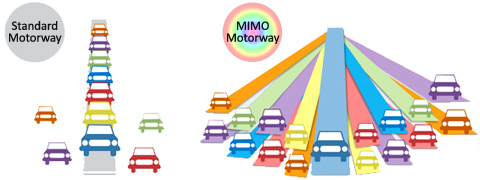
The impact of massive MIMO has been likened to that of using a multi-lane motorway. On a standard motorway, each car shares a few lanes with other drivers and thus is constrained in what it can do by the other cars on the road. On a massive MIMO motorway, each car has its own lane and thus can do what it wishes.
There is one potential concern that MIMO brings. If you imagine all 256 antennas pointing in the same direction, the cumulative amount of radio energy being sent in that direction could be very high and some have expressed fears that this may exceed safety thresholds. The ITU has even held a workshop on the topic. The concerns also centre around the fact that it is foreseen that 5G cell deployments will be on structures such as street and traffic lights which put them much closer to pedestrians and drivers than existing deployments. Nonetheless, massive MIMO is a key part of 5G technology and will bring significant gains in spectrum efficiency.
In old fashioned radio technologies, the transmitter uses a single antenna to emit a signal, and the receiver uses a single antenna to receive the signal (incidentally known as single input, single output or SISO). This works fine but neglects one of the most common propagation conditions that can upset reception of a radio signal: reflections. The reception of a signal reflected off an object in addition to the direct signal can lead to all manner of problems. One of the most common was, in the days of analogue television, what was known as 'ghosting'.
 Analogue television pictures are drawn line-by-line by a dot that whizzes across the screen from left to right. Any reflection will, by the simple laws of geometry, have travelled further than one directly from the transmitter and thus will take slightly longer to arrive. This produces a second image, that is 'delayed' compared to the direct signal, and this delayed picture would appear to the left of the main signal, as a ghost of the main picture.
Analogue television pictures are drawn line-by-line by a dot that whizzes across the screen from left to right. Any reflection will, by the simple laws of geometry, have travelled further than one directly from the transmitter and thus will take slightly longer to arrive. This produces a second image, that is 'delayed' compared to the direct signal, and this delayed picture would appear to the left of the main signal, as a ghost of the main picture. In digital television, this problem has been dealt with by slowing down the transmission of the data, such that the typical length of a delay (measured in microseconds) is far less than the length of time used to send each bit, and thus you can effectively ignore the short period of time for which the delayed signal and the direct signal might be different from each other and switch off the receiver for a short while until the situation settles down. The time which the receiver waits for the situation to settle down is known as the guard interval and can be adjusted by the broadcaster to take account of different reflection environments (i.e. in a city where reflections tend to be strong, but over small distances, compared to in a rural area where the reflections might be from buildings or structures several kilometers away).

But what if you could be cleverer than just ignoring the reflection, and find a way of using it to benefit reception instead of being a detriment to it? Take the example illustrated above. A single transmitter is being received by two adjacent antennas, but as well as receiving a signal that has travelled directly from the transmitter, they are also receiving a reflection. If the signal being received at each antenna is compared with the other, the direct signal will appear identical, having travelled exactly the same distance. The reflection, however, will be different at each antenna, having travelled marginally different distances.
This fact can be used to do something very clever. If you compare the signals at both antennas, and only seek out the elements that are identical, you can effectively filter out the direct signal and throw away the reflection. However, you can go one step further. If you subtract the signal at one antenna from that of the other, the direct signal will cancel out, and you will be left with only the reflected signal. Thus it is possible to receive both the direct signal and the reflected signal independently from one another.
Now imagine you could tell the transmitter this information (i.e. that you were receiving two copies of the signal it was transmitting, one directly and one via a reflection). Using the same techniques but in reverse, it would be possible for the transmitter to send two independent sets of information, one via the direct path, and one via the reflection. You could use the same frequency twice between the same two points, doubling spectrum efficiency in one swipe. By using more antennas, more reflections can be handled and the same frequency can be re-used multiple times.
Such techniques are not science-fiction. One of the most important developments of recent years is the implementation of what is known as Multiple Input, Multiple Output (MIMO) technology. MIMO uses more than one antenna both at the transmitter and receiver to achieve exactly this outcome. One of the first widespread uses of MIMO was in the IEEE 802.11n standard for WiFi. This can use up to 4 antennas for the transmitter and up to 4 for the receiver. As reflections are common indoors (e.g. from walls, ceilings) this works very well and allows the same frequency to be re-used multiple times to achieve higher data throughput (theoretically up to 600 Mbps). This technique has been built into WiFi hotspots, laptops and mobile phones since the early 2010s and is now defacto in new devices.
 4G (LTE) also uses MIMO techniques to do exactly the same thing. It is becoming increasingly common for at least 4 antennas to be used at the base station and 2 or more in a mobile handset. Where 5G will change this, is that what is being called 'massive MIMO' will be employed. This means that the base station may have up to 256 antennas, and potentially something similar in handsets. This will allow the same frequencies to be reused hundreds of times within a cell, making spectrum efficiency very high, but also massively increasing the capacity of a cell and thus the connection speed experienced by the users.
4G (LTE) also uses MIMO techniques to do exactly the same thing. It is becoming increasingly common for at least 4 antennas to be used at the base station and 2 or more in a mobile handset. Where 5G will change this, is that what is being called 'massive MIMO' will be employed. This means that the base station may have up to 256 antennas, and potentially something similar in handsets. This will allow the same frequencies to be reused hundreds of times within a cell, making spectrum efficiency very high, but also massively increasing the capacity of a cell and thus the connection speed experienced by the users.You might think that 256 antennas will weigh down cell towers, but as we are mostly talking about frequencies above 24 GHz, which have a wavelength of 1.2 cm or less, an array of 16 antennas high by 16 across (i.e. 256 in total) need only be 20 cm square. Even at lower frequencies such as 2.6 GHz which has a wavelength of 12 cm, and a panel of 4 antennas wide by 8 high, each antenna having both horizontal and vertical polarisation (making for 64 MIMO antennas) would only measure roughly 50 cm across and 1 m high, which is not that much bigger than traditional panel antennas used today. The picture on the left is of a 2.6 GHz MIMO panel antenna in use at the 5G Innovation Centre in the UK.
Another way to think about massive MIMO is to consider that with 256 antennas, you could use them in the same way as elements of a directional antenna, and form narrow beams pointing at each user. Each user could then use the full amount of spectrum that is available in the cell (or more if there are enough spare antennas to also handle the reflections). This is known as beamforming, and is one of the applications of MIMO.

The impact of massive MIMO has been likened to that of using a multi-lane motorway. On a standard motorway, each car shares a few lanes with other drivers and thus is constrained in what it can do by the other cars on the road. On a massive MIMO motorway, each car has its own lane and thus can do what it wishes.
There is one potential concern that MIMO brings. If you imagine all 256 antennas pointing in the same direction, the cumulative amount of radio energy being sent in that direction could be very high and some have expressed fears that this may exceed safety thresholds. The ITU has even held a workshop on the topic. The concerns also centre around the fact that it is foreseen that 5G cell deployments will be on structures such as street and traffic lights which put them much closer to pedestrians and drivers than existing deployments. Nonetheless, massive MIMO is a key part of 5G technology and will bring significant gains in spectrum efficiency.
Thursday 30 August, 2018, 14:45 - Spectrum Management, Much Ado About Nothing
Posted by Administrator
Posted by Administrator
 Ofcom has published a report called "Advice to Government on improving rail passenger access to data services, Spectrum for trackside connectivity solutions and rail passenger data demand". In it, they examine the amount of data needed to supply connectivity to passengers and then which spectrum band is best suited to supply these needs.
Ofcom has published a report called "Advice to Government on improving rail passenger access to data services, Spectrum for trackside connectivity solutions and rail passenger data demand". In it, they examine the amount of data needed to supply connectivity to passengers and then which spectrum band is best suited to supply these needs.The amount of data that each passenger will be consuming each month is taken directly from Ofcom's "Mobile Data Strategy" which was published in 2016. These range from 50 to 200 Gbytes per month in 2025 depending on the scenario. The report assumes that 80% of this data is offloaded onto WiFi and that it will be a WiFi service that is provided on the train.
 If this is the case, the average user will consume between 40 and 160 Gbytes of WiFi data per month, which is 1.3 to 5.3 Gbytes per day. If we take Ofcom's figures that there will be between 600 and 1440 passengers on busy commuter trains, and that a typical commute on a train lasts 1 hour, then the total amount of data per hour consumed by all the passengers between 33 and 315 Gbytes. This, in turn, equates to a connectivity requirement of between 73 and 700 Mbps. Of course, this assumes that every passenger on the train uses the WiFi service that is provided, which is unlikely to be the case, especially (as Ofcom also notes) if the service requires a payment to connect to.
If this is the case, the average user will consume between 40 and 160 Gbytes of WiFi data per month, which is 1.3 to 5.3 Gbytes per day. If we take Ofcom's figures that there will be between 600 and 1440 passengers on busy commuter trains, and that a typical commute on a train lasts 1 hour, then the total amount of data per hour consumed by all the passengers between 33 and 315 Gbytes. This, in turn, equates to a connectivity requirement of between 73 and 700 Mbps. Of course, this assumes that every passenger on the train uses the WiFi service that is provided, which is unlikely to be the case, especially (as Ofcom also notes) if the service requires a payment to connect to.Having presumably done the same calculations, Ofcom has arrived at a requirement of between 400 Mbps and 3.6 Gbps, or roughly 5 times more. So either train journey in Ofcom's world are 5 times longer, or people on trains are 5 times more hungry for data than normal individuals.
 Based on these figures, Ofcom have assumed that a benchmark connectivity speed should be around 1 Gbps for trains. It has then gone on to analyse the various spectrum options, and decided that the only band that can deliver the necessary connectivity is the 26 GHz band, which is one of the bands being touted for future 5G services. It completely excludes, for example, the use of the 2.7 - 2.9 GHz band as it claims that this could only deliver 100 Mbps of connectivity (assuming that 40 MHz of it could be made available). It also discounts the 5.4 GHz band as this could only deliver 'a few hundred Mbps'.
Based on these figures, Ofcom have assumed that a benchmark connectivity speed should be around 1 Gbps for trains. It has then gone on to analyse the various spectrum options, and decided that the only band that can deliver the necessary connectivity is the 26 GHz band, which is one of the bands being touted for future 5G services. It completely excludes, for example, the use of the 2.7 - 2.9 GHz band as it claims that this could only deliver 100 Mbps of connectivity (assuming that 40 MHz of it could be made available). It also discounts the 5.4 GHz band as this could only deliver 'a few hundred Mbps'. There are, though, significant issues with the 26 GHz band:
- Coverage of a 26 GHz 'cell' is expected to be a few 100 metres only, which would mean tens of thousands of cells would be needed to cover the UK rail network.
- Trains run at up to 200 km/h, this places extreme demands on handovers if cells are close together, let alone dealing with Doppler shift and Rayleigh fading.
- The 26 GHz band has been identified as a 'pioneer' band for 5G services in Europe and is likely to be in high demand from mobile operators for their future mobile services.
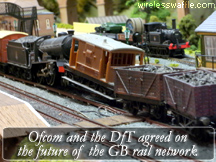 There is, however, a very simple solution to the whole problem. If we shrink the size of the rail network to be only a few hundred metres long, then the 26 GHz solution will work perfectly. This, perversely, seems to be the plan of the Department for Transport who allow companies such as Southern, Thameslink, Hull Trains and Northern Trains to implement new timetables that effectively reduce the rail network to set of toys, that can't convey passengers anyway. Bravo, Ofcom, for realising that the rail industry will be reduced to OO-gauge before long anyway.
There is, however, a very simple solution to the whole problem. If we shrink the size of the rail network to be only a few hundred metres long, then the 26 GHz solution will work perfectly. This, perversely, seems to be the plan of the Department for Transport who allow companies such as Southern, Thameslink, Hull Trains and Northern Trains to implement new timetables that effectively reduce the rail network to set of toys, that can't convey passengers anyway. Bravo, Ofcom, for realising that the rail industry will be reduced to OO-gauge before long anyway.Thursday 21 June, 2018, 17:42 - Spectrum Management
Posted by Administrator
Posted by Administrator
 Wireless Waffle regularly peruse published data on all manner of radio and related topics to bring you our often orthogonal analyses of various subjects leading to outcomes that others may not have considered. It is with exactly that kind of hat on, that we were looking at the figures produced by Ericsson in its annual Mobility Report. In the report, they give the number of subscribers with a mobile connection, which in 2017 stood at 5.3 billion, up from 5 billion in 2016. This does not include 'machine' subscriptions, nor multiple subscriptions by the same person (i.e. where someone has a phone and a tablet computer, or a work phone and a personal phone) and therefore represents just the number of actual people with a mobile connection.
Wireless Waffle regularly peruse published data on all manner of radio and related topics to bring you our often orthogonal analyses of various subjects leading to outcomes that others may not have considered. It is with exactly that kind of hat on, that we were looking at the figures produced by Ericsson in its annual Mobility Report. In the report, they give the number of subscribers with a mobile connection, which in 2017 stood at 5.3 billion, up from 5 billion in 2016. This does not include 'machine' subscriptions, nor multiple subscriptions by the same person (i.e. where someone has a phone and a tablet computer, or a work phone and a personal phone) and therefore represents just the number of actual people with a mobile connection.The interesting fact from amongst these statistics is that the growth in new mobile subscribers is slowing, and using forecasting based on the 'it fits a nice curve so is probably right' school of highly advanced bistromathics, by 2020, new additions will have fallen to just 1% more than in the previous year reaching around 5.7 billion. World population growth is forecast to be around 1.15% in the same year reaching around 7.8 billion.
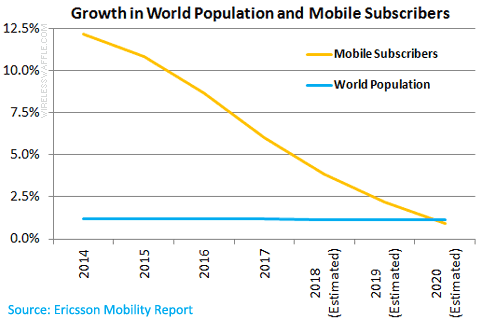
Digging slightly deeper into the figures, what becomes clear is that during 2020, the number of new mobile subscribers will be less than the number of new people on the planet. In 2019, the number of people without a mobile subscription is estimated (by Wireless Waffle) to be 2.08 billion. In 2020 the number of people without a mobile subscription is estimated to be 2.11 billion, or 30 million more.
This is an interesting conclusion. It means that within 2 years, the number of people on the Earth without a mobile subscription will begin to grow. The number of those without access to mobile telecommunications will get bigger. Or put in other terms, the digital divide (between the 'haves' and the 'have nots') will get worse. This appears to be down to two main factors:
 Coverage: Although coverage is still increasing in many countries, it is slowing down. In particular, coverage in rural or remote areas is not changing significantly, as it proves increasingly costly to reach these hard to get to places.
Coverage: Although coverage is still increasing in many countries, it is slowing down. In particular, coverage in rural or remote areas is not changing significantly, as it proves increasingly costly to reach these hard to get to places.- Price: The cost of mobile subscriptions is no longer falling significantly as operators fight to recoup their investments in 3G and 4G. As such, those who can afford a connection already have one, and other than general growth trends increasing the income of the lowest paid, those who cannot afford a connection are unlikely to be able to do so any time soon.
At the same time as the digital divide is set to grow, mobile operators and mobile equipment vendors are hell-bent on introducing new technologies including 5G and millimetre wave. Both these technologies will provide bucket loads of capacity and throughput, but cell sizes are generally going to be limited to a few hundred metres at most, and capacity will be focussed on dense urban areas where there is profit to be made selling such services to data hungry consumers. They are also not cheap and nor will they be incorporated into low-end mobile handsets. The upshot of this is that 5G and millimetre wave technologies will not improve coverage, indeed they will excentuate the urban/rural divide, and they will also do nothing to make services more cost-effective, they will exacurbate the problem.
There is no simple answer to the problems of coverage and price,
 other than mobile operators taking different investment decisions based not necessarily on commercial return, but on providing a public service. Of course they are commercial companies and thus neither obliged nor motivated to become public servants, which is why it might be time for governments to step in. This has happened already in many countries when it comes to investment in fibre, in that a market failure has been identified, and governments have stepped in to fund fibre roll-out to otherwise uneconomical places. The fibre has then been offered on a wholesale basis to anyone who wished to use it.
other than mobile operators taking different investment decisions based not necessarily on commercial return, but on providing a public service. Of course they are commercial companies and thus neither obliged nor motivated to become public servants, which is why it might be time for governments to step in. This has happened already in many countries when it comes to investment in fibre, in that a market failure has been identified, and governments have stepped in to fund fibre roll-out to otherwise uneconomical places. The fibre has then been offered on a wholesale basis to anyone who wished to use it.Maybe the same is now needed for wireless services. The 700 MHz band, for example, is a good candidate to provide rural and remote area coverage at reasonable cost. Instead of auctioning all of the band off to the highest bidder, governments could reserve some (or all) of the band for a national wholesale operator whose target is rural/remote coverage and sell this back to the other operators on a wholesale basis (they could even share the spectrum on a geographic basis with the main operators who could use it in urban/suburban areas). The governments of Mexico and Rwanda are already doing just this, and it makes sense: building just one network in hard to get to places, is, even using basic bistromathics, around four times cheaper than building one network per operator (assuming there are four operators).
One thing that will not solve the problem, is finding yet more radio spectrum for mobile services. Introducing new mobile bands such as those touted at 26 GHz and above, will do absolutely nothing to improve the situation. Today's problem is no longer capacity, it is coverage and price. And spectrum is not the solution, revised government thinking just might be.

